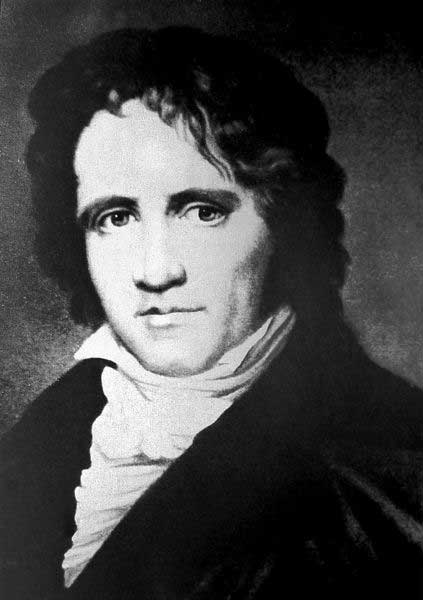.
Friedrich Bessel

Friedrich Wilhelm Bessel (22 July 1784 – 17 March 1846) was a German mathematician, astronomer, and systematizer of the Bessel functions (which were discovered by Daniel Bernoulli). He was a contemporary of Carl Gauss, also a mathematician and astronomer. The asteroid 1552 Bessel was named in his honour.
Life and work
Bessel was born in Minden in Minden-Ravensberg, the son of a civil servant. At the age of 14 Bessel was apprenticed to the import-export concern Kulenkamp. He soon became the company's accountant. The business's reliance on cargo ships led him to turn his mathematical skills to problems in navigation. This in turn led to an interest in astronomy as a way of determining longitude.
Bessel came to the attention of a major figure of German astronomy at the time, Heinrich Wilhelm Olbers, by producing a refinement on the orbital calculations for Halley's Comet. Within two years Bessel had left Kulenkamp and become an assistant at Lilienthal Observatory near Bremen. There he worked on James Bradley's stellar observations to produce precise positions for some 3,222 stars.
This work attracted considerable attention, and at the age of 26 Bessel was appointed director of the Königsberg Observatory by King Frederick William III of Prussia. There he published tables of atmospheric refraction based on Bradley's observations, which won him the Lalande Prize from the Institut de France. Bessel was able to pin down the position of over 50,000 stars during his time at Königsberg.
With this work under his belt, Bessel was able to achieve the feat for which he is best remembered today: he is credited with being the first to use parallax in calculating the distance to a star. Astronomers had believed for some time that parallax would provide the first accurate measurement of interstellar distances—in fact, in the 1830s there was a fierce competition between astronomers to be the first to measure a stellar parallax accurately. In 1838 Bessel won the race, announcing that 61 Cygni had a parallax of 0.314 arcseconds; which, given the diameter of the Earth's orbit, indicated that the star was about 3 parsecs (9.8 light years) away. There are more recent results in the article on 61 Cygni. He narrowly beat Friedrich Georg Wilhelm Struve and Thomas Henderson, who measured the parallaxes of Vega and Alpha Centauri in the same year.
As well as helping determine the parallax of 61 Cygni, Bessel's precise measurements allowed him to notice deviations in the motions of Sirius and Procyon, which he deduced must be caused by the gravitational attraction of unseen companions. His announcement of Sirius's "dark companion" in 1844 was the first correct claim of a previously unobserved companion by positional measurement, and eventually led to the discovery of Sirius B.
Despite lacking a university education, Bessel was a major figure in astronomy during his lifetime. He was elected a fellow of the Royal Society, a foreign member of the Royal Swedish Academy of Sciences in 1823, and the largest crater in the Moon's Mare Serenitatis is named Bessel after him. Bessel's work in 1840 contributed in some degree to the discovery of Neptune. Bessel won the Gold Medal of the Royal Astronomical Society in 1841.
In the second decade of the 19th century while studying the dynamics of 'many-body' gravitational systems, Bessel developed what are now known as Bessel functions. Critical for the solution of certain differential equations, these functions are used throughout both classical and quantum physics. Even in the absence of any work in astronomy, Bessel's role in developing the functions which now bear his name would have, by itself, placed him among the most significant and influential mathematicians of the 19th century.
In 1846 he died in Königsberg of cancer.
Further reading
* Fricke, Walter (1970–80). "Bessel, Friedrich Wilhelm". Dictionary of Scientific Biography. 2. New York: Charles Scribner's Sons. pp. 97–102. ISBN 0684101149.
References
* John Frederick William Herschel, A brief notice of the life, researches, and discoveries of Friedrich Wilhelm Bessel, London: Barclay, 1847 (on-line)
* Karl Christian Bruhns, «Bessel, Friedrich Wilhelm». In: Allgemeine Deutsche Biographie (ADB). Band 2. Duncker & Humblot, Leipzig 1875, pp. 558–567 (on-line)
External links
* O'Connor, John J.; Robertson, Edmund F., "Friedrich Bessel", MacTutor History of Mathematics archive, University of St Andrews, http://www-history.mcs.st-andrews.ac.uk/Biographies/Bessel.html .
* Friedrich Bessel at the Mathematics Genealogy Project
Retrieved from "http://en.wikipedia.org/"
All text is available under the terms of the GNU Free Documentation License


